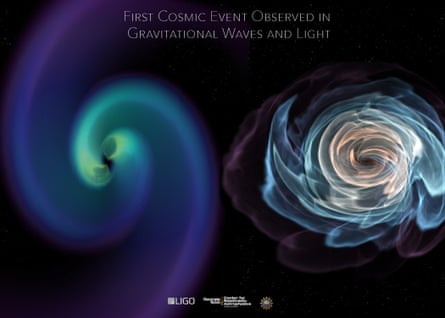The collision of a pair of neutron stars, marked by ripples through the fabric of space-time and a flash brighter than a billion suns, has been witnessed for the first time in the most intensely observed astronomical event to date.
The extraordinary sequence, in which the two ultra-dense stars spiralled inwards, violently collided and, in all likelihood, immediately collapsed into a black hole, was first picked up by the US-based Laser Interferometer Gravitational-Wave Observatory (Ligo).
As its twin detectors, in Louisiana and Washington state, picked up tremors in space-time that had spilled out from the merger 130m light years away, an alert went out to astronomers across the globe. Within hours, 70 space- and ground-based telescopes swivelled to observe the red-tinged afterglow, making it the first cosmic event to be “seen” in both gravitational waves and light.
Dave Reitze, executive director of Ligo, said: “What is amazing about this discovery is it is the first time we’ve got a full picture of one of the most violent, cataclysmic events in the universe. This is the most intense observational campaign there has ever been.”
Einstein first predicted the existence of gravitational waves a century ago, but the first experimental proof that space itself can be stretched and squeezed took until 2015, when Ligo scientists detected a collision of black holes. But this dark merger, and the three detected since, were invisible to conventional telescopes.
This time, as the stars collided, they emitted an intense beam of gamma rays and the sky was showered with heavy elements, resolving a decades-old debate about where gold and platinum come from.
Neutron stars are the smallest, densest stars known to exist: about 12 miles wide, with a teaspoon of neutron star material having a mass of about a billion tons. The core is a soup of pure neutrons, while the crust is smooth, solid and 10 billion times stronger than steel.
The 100-second hum picked up by Ligo told the story of how the two stars, each slightly heavier than the sun, approached their death. Initially separated by 200 miles, they circled each other 30 times a second. As they whirled inwards, accelerating to 2,000 orbits each second, the signal rose in pitch like a slide whistle.
Two seconds later, Nasa’s Fermi space telescope picked up an intense burst of gamma rays, emitted as shockwaves rushed through jets of matter funnelled out of the poles during the monumental impact of the collision.
What happened next is uncertain. A neutron star weighing more than twice the mass of the sun (the combined mass here) has never been seen before – but neither has a black hole so small. Theoretical predictions suggest an almost instantaneous gravitational collapse into a black hole is most likely.
“Neutron stars are at this sweet spot between a star and a black hole,” said Prof Andreas Freise, a Ligo project scientist at the University of Birmingham. “When two of them collide, we expect them to immediately collapse into a black hole, leaving behind a bit of dust and stuff.”
David Shoemaker, spokesman for the Ligo Scientific Collaboration, said: “It’s [probably] the first observation of a black hole being created where there was none before, which is pretty darn cool.”

The observations herald a new era of rapid-response astronomy, in which transient and unexpected cosmic events can be observed in detail for the first time. When Ligo’s software picked up a signal at 1:41pm UK time on 17 August, Shoemaker was one of a small team at Ligo to be alerted by a ringtone on his phone reserved for when black holes or neutron stars collide.
“My phone went off and I smiled,” he said.
Within an hour, the detection had been confirmed by Virgo, a European gravitational wave detector near Pisa, the source of the signal had been triangulated to a small patch of sky and a global alert was triggered.
Prof Stephen Smartt, of Queen’s University Belfast, was leading a five-day observation run of supernovae on the New Technology Telescope at La Silla, Chile, when the news came in.
“We dropped everything and pointed at that bit of sky,” he said. “This was the most unusual object we’d ever seen.”
Smartt’s team, and those on other telescopes, observed the faint new blob and measured its spectrum to assess the chemical composition. The blob was a fireball of radioactive heavy chemical elements, known as a kilonova, that had been blown out from the collision at one fifth of the speed of light shortly after the gamma ray burst.
Previously, scientists had speculated that the sheer force of neutron star collisions would be enough to force extra neutrons into the nuclei of atoms, forging heavy elements like gold and platinum, but until now this idea was purely theoretical.
“People have been looking for that forever,” said Freise.
“This is the first real confirmation that heavy elements such as gold, platinum and uranium are either solely or predominantly produced in binary neutron star collisions,” said Reitze. “The wedding band on your finger or the gold watch you’re wearing was most likely produced a billion years ago by two neutron stars colliding. That’s pretty cool.”
Earlier this month, three US scientists who played a crucial role in the development of Ligo were awarded the Nobel prize in physics for the first detection of gravitational waves. Shoemaker pointed out that two of the new laureates – and others – had been working on the project long before it captured the world’s attention
“This kind of thing doesn’t happen because there are suddenly neat instruments,” he said. “It’s decades of work and people working together in a collaborative way. It’s quite phenomenal.”
The findings were published on Monday in a series of papers in journals including Science, Nature and Physics Review Letters.
Comments (…)
Sign in or create your Guardian account to join the discussion